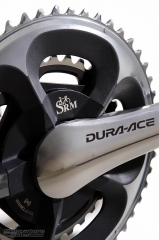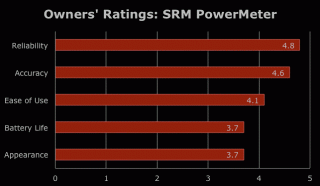
Cycling is an easy sport to get in to, but once initiated the pursuit of better fitness is never ending. The more we commit ourselves to the sport, the greater time commitment is needed to produce measurable gains. The calendar has just recently turned over and for most of us a new year means setting new goals. And, new goals often require a new method of tracking our progress.
Unlike heart rate, which can be effected by environmental conditions, power is considered the only absolute measure of performance and fitness on a bicycle. The German company SRM was the first to create a system of measuring power on a bicycle in real world conditions, outside of a lab. Today they remain the leader in the field, but new competitors enter the market every year.
Signature Cycles is the fourth largest SRM dealer in the United States and the largest brick-and-mortar retailer. For our second owner’s survey we reached out to our SRM PowerMeter users to find out their thoughts on the marquee bicycle power system.
The Results
Twelve SRM owners responded to our survey. One quarter of the responding owners were relatively new to the SRM system, having used it for 6 months or less. The rest had spent considerable time, each riding with their power meter for greater than two years.

The SRM PowerMeter is a crankset-based system that transmits power data to a computer head unit. The vast majority of SRM owners use the matching Power Control computer head to view their power data while on the bike. However, the Garmin computers were also popular, primarily the Edge 800 model.
It seems that the SRM PowerMeter is often the choice of the experienced power user. Over 80% of respondents said that they bought an SRM after using another system first. The majority had come from the PowerTap hub sytem, two from Polar Power, and one from a Quark crankset power meter.
Expense may be a reason why the SRM system is less frequently selected by a rider newly interested in training with power. When owners were asked what they would change about the SRM PowerMeter, 70% said the price.
However, cost may be on owners minds simply because the SRM system has left them little else to worry about. In our rating section, reliability earned a 4.8 out of 5. Accuracy was rated a 4.6, and ease of use received a 4.1. Battery life and appearance left a little room for improvement with a rating of 3.7 for each.

Accuracy and reliability were also the most frequent comments when owners listed the advantages of SRM over other power systems. “Ease of changing wheels” was another comment, which spoke to the practice of using one wheelset for training and another to race. One respondent went into more detail about the SRM ownership experience saying, “SRM help desk in Colorado is the real deal; very knowledgeable people on the line at all times who really care about their product.”
We also surveyed SRM Owners about their training habits. 75% of the respondents said that they work with a coach to analyze their power data. Equally as many riders use an online site to track their performances either instead of, or in addition to, a personal coach. TrainingPeaks.com was the most popular, followed closely by Connect.Garmin.com. PowerCoach.ch was also mentioned.
When it was introduced, the SRM PowerMeter crank system created a new way to train on a bicycle. The company has retained it’s prominence in an extremely competitive industry through careful refinement of their original idea. We like to end our surveys with a final “yes” or “no” question. Despite any drawbacks compared to other power systems, when asked whether they would recommend the SRM PowerMeter to a friend, 100% of responding owners said “yes.”




One comment
Trackbacks
The comments are closed.